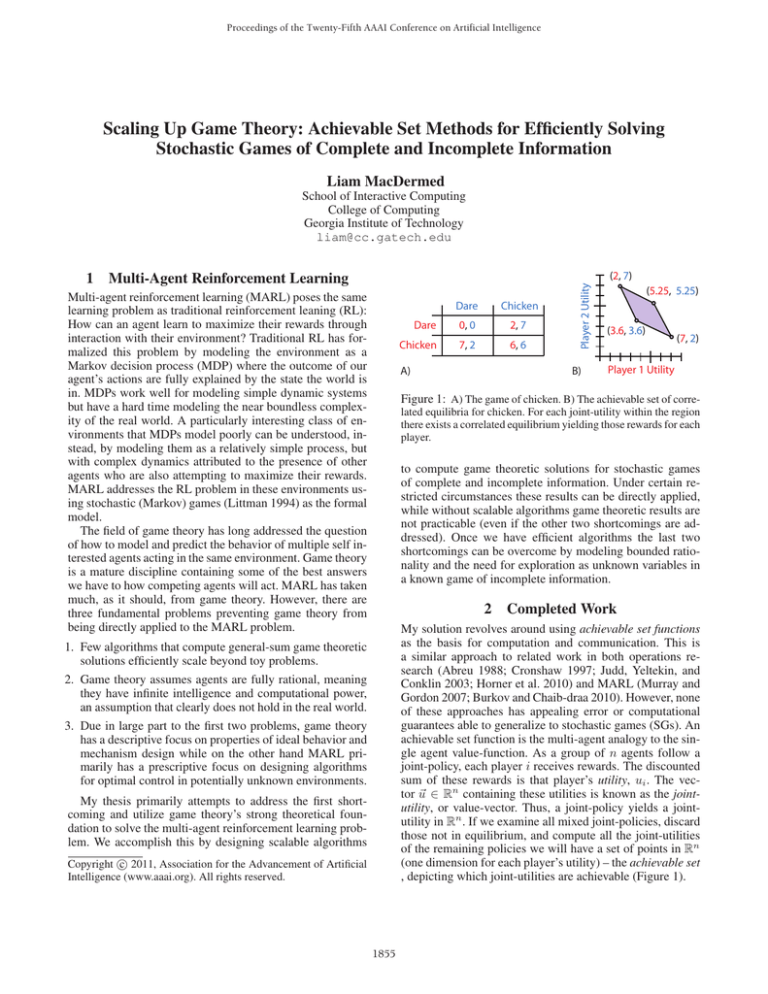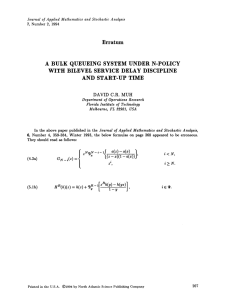
Proceedings of the Twenty-Fifth AAAI Conference on Artificial Intelligence
Scaling Up Game Theory: Achievable Set Methods for Efficiently Solving
Stochastic Games of Complete and Incomplete Information
Liam MacDermed
School of Interactive Computing
College of Computing
Georgia Institute of Technology
liam@cc.gatech.edu
(2, 7)
Multi-Agent Reinforcement Learning
Multi-agent reinforcement learning (MARL) poses the same
learning problem as traditional reinforcement leaning (RL):
How can an agent learn to maximize their rewards through
interaction with their environment? Traditional RL has formalized this problem by modeling the environment as a
Markov decision process (MDP) where the outcome of our
agent’s actions are fully explained by the state the world is
in. MDPs work well for modeling simple dynamic systems
but have a hard time modeling the near boundless complexity of the real world. A particularly interesting class of environments that MDPs model poorly can be understood, instead, by modeling them as a relatively simple process, but
with complex dynamics attributed to the presence of other
agents who are also attempting to maximize their rewards.
MARL addresses the RL problem in these environments using stochastic (Markov) games (Littman 1994) as the formal
model.
The field of game theory has long addressed the question
of how to model and predict the behavior of multiple self interested agents acting in the same environment. Game theory
is a mature discipline containing some of the best answers
we have to how competing agents will act. MARL has taken
much, as it should, from game theory. However, there are
three fundamental problems preventing game theory from
being directly applied to the MARL problem.
Dare
Chicken
Dare
0, 0
2, 7
Chicken
7, 2
6, 6
A)
Player 2 Utility
1
B)
(5.25, 5.25)
(3.6, 3.6)
(7, 2)
Player 1 Utility
Figure 1: A) The game of chicken. B) The achievable set of correlated equilibria for chicken. For each joint-utility within the region
there exists a correlated equilibrium yielding those rewards for each
player.
to compute game theoretic solutions for stochastic games
of complete and incomplete information. Under certain restricted circumstances these results can be directly applied,
while without scalable algorithms game theoretic results are
not practicable (even if the other two shortcomings are addressed). Once we have efficient algorithms the last two
shortcomings can be overcome by modeling bounded rationality and the need for exploration as unknown variables in
a known game of incomplete information.
2
Completed Work
My solution revolves around using achievable set functions
as the basis for computation and communication. This is
a similar approach to related work in both operations research (Abreu 1988; Cronshaw 1997; Judd, Yeltekin, and
Conklin 2003; Horner et al. 2010) and MARL (Murray and
Gordon 2007; Burkov and Chaib-draa 2010). However, none
of these approaches has appealing error or computational
guarantees able to generalize to stochastic games (SGs). An
achievable set function is the multi-agent analogy to the single agent value-function. As a group of n agents follow a
joint-policy, each player i receives rewards. The discounted
sum of these rewards is that player’s utility, ui . The vector u ∈ Rn containing these utilities is known as the jointutility, or value-vector. Thus, a joint-policy yields a jointutility in Rn . If we examine all mixed joint-policies, discard
those not in equilibrium, and compute all the joint-utilities
of the remaining policies we will have a set of points in Rn
(one dimension for each player’s utility) – the achievable set
, depicting which joint-utilities are achievable (Figure 1).
1. Few algorithms that compute general-sum game theoretic
solutions efficiently scale beyond toy problems.
2. Game theory assumes agents are fully rational, meaning
they have infinite intelligence and computational power,
an assumption that clearly does not hold in the real world.
3. Due in large part to the first two problems, game theory
has a descriptive focus on properties of ideal behavior and
mechanism design while on the other hand MARL primarily has a prescriptive focus on designing algorithms
for optimal control in potentially unknown environments.
My thesis primarily attempts to address the first shortcoming and utilize game theory’s strong theoretical foundation to solve the multi-agent reinforcement learning problem. We accomplish this by designing scalable algorithms
c 2011, Association for the Advancement of Artificial
Copyright Intelligence (www.aaai.org). All rights reserved.
1855
In MacDermed & Isbell (2009) we show how to efficiently approximate with bounded error the achievable set
in stochastic games. This is the first work to give such guarantees. Although theoretically the guarantees in this work
promise the first polynomial efficiency and precision guarantees along a number of dimensions, practically the work
requires solving sequences of multi-objective linear programs which in practice are quite slow and still limit the
complexity of the stochastic games they can solve. In MacDermed et al. (2010) we show how to make this computation
even more efficient by representing achievable sets as polytopes (intersections of half-spaces) instead of convex hulls.
This results in solving a series of linear programs instead of
multi-objective LPs and allows stochastic games with many
more actions and a few more players to be tractably solved
with greater precision.
The above work all assumes complete information (including knowing the other player’s reward function). Although in some scenarios this is a reasonable assumption
(for example in mechanism design), in most cases either the
other agent’s goals aren’t exactly known or the other agent
doesn’t perfect act in accordance with their goals (bounded
rationality). Both cases can be modeled as playing a game
with incomplete information. Towards this end we have developed a new model: Markov games of incomplete information (MGII) (Mac Dermed, Isbell, and Weiss 2010). This
model is distinct from and a subset of the existing model of
partially observable stochastic games (POSG), in that MGIIs
prevent the formation of nested beliefs and permit a bounded
enumeration of private information (types) while POSGs do
not.
While solving stochastic games of incomplete information are extremely difficult (POMDPs are a special case) we
have shown how our solution to the complete information
case can be extended to the incomplete case when belief
states obey the Markov property and are chosen independently at random every state. This can model both uncertainty and noise over other players’ preferences leading to
more robust policies. We also argue that such uncertainty
and noise can capture the bounded rationality of other players and diminish our results’ sensitivity to the assumption of
rationality.
3
stochastic games. Instead of playing a sequence of normalform games (which are exponential in the number of players), agents will play a sequence of action-graph games. Action graph games compactly represent the interaction between many agents by taking advantage of symmetry and
independencies in the structure of the game. Extending this
compact representation to stochastic games is non-trivial as
both asymmetries and dependences persist over time.
While complex, such a model will not only help with scaling the number of players but also the number of unknown
variables in games of incomplete information. MGIIs can
be solved by transforming them into completely observable
games with many players, one for each type (Mac Dermed,
Isbell, and Weiss 2010). These games however have a great
deal of structure which can be captured by action-graph
games and exploited to produce more efficient algorithms.
Finally I propose to demonstrate the practicality and usefulness of these approaches by applying them to real world
problems. For the complete information case, we will solve
a multi-agent package delivery domain and test our results
against other learning algorithms. For the incomplete information case we plan to examine different reputation metrics and examine their theoretical effectiveness in simulated
buyer-seller environment with limited communication.
References
Abreu, D. 1988. On the theory of infinitely repeated games
with discounting. Econometrica 56(2):383–96.
Burkov, A., and Chaib-draa, B. 2010. An approximate
subgame-perfect equilibrium computation technique for repeated games. In Twenty Fourth AAAI Conference on Artificial Intelligence (AAAI ’10).
Cronshaw, M. B. 1997. Algorithms for finding repeated
game equilibria. Computational Economics 10(2):139–68.
Horner, J.; Sugaya, T.; Takahashi, S.; and Vieille, N. 2010.
Recursivemethods in discounted stochastic games: an algorithm for δ → 1 and a folk theorem. Econometrica.
Judd, K. L.; Yeltekin, S.; and Conklin, J. 2003. Computing
supergame equilibria. Econometrica 71(4):1239–1254.
Littman, M. L. 1994. Markov games as a framework for
multi-agent reinforcement learning. In Proc. 11th International Conf. on Machine Learning (ICML), 157–163. Morgan Kaufmann.
Mac Dermed, L., and Isbell, C. L. 2009. Solving stochastic games. In Advances in Neural Information Processing
Systems 22. 1186–1194.
Mac Dermed, L.; Narayan, K. S.; Isbell, C. L.; and Weiss, L.
2010. Quick polytope approximation of all correlated equilibria in stochastic games. In Twenty Fifth AAAI Conference
on Artificial Intelligence (AAAI ’11).
Mac Dermed, L.; Isbell, C. L.; and Weiss, L. 2010. Markov
games of incomplete information for multi-agent reinforcement learning.
Murray, C., and Gordon, G. J. 2007. Multi-robot negotiation: Approximating the set of subgame perfect equilibria in
general-sum stochastic games. In Advances in Neural Information Processing Systems 19. 1001–1008.
Future Work
Although I have shown how to compute correlated equilibria
in stochastic games efficiently with respect to the number of
states and actions, I propose to improve scalability with respect to the number of players and unknown variables, both
of which currently scale exponentially for all known methods. Also, while the achievable set method has been tested
extensively on random Markov games and small games with
known closed form solutions, I propose to apply our algorithms to a number of real world applications. Thus my
dissertation will attempt to demonstrate that achievable set
methods can efficiently compute useful game theoretic solutions to general multi-agent reinforcement learning problems.
I will address the problem of scalability by developing a
new hybrid model that will merge action-graph games with
1856






